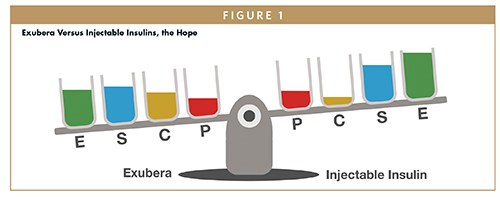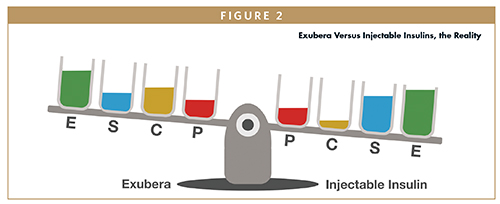Issue:April 2021
PRODUCT DEVELOPMENT STRATEGY - ESCP, Estimating Product Performance Part 2 – Choosing a Seesaw
By: Josef Bossart, PhD
INTRODUCTION
In last month’s introductory article, the concept of ESCP (Efficacy, Safety/Tolerability, Convenience, Pricing), seesaws, and buckets was introduced as a visual and intuitive way to understand and estimate the marketplace potential for new pharmaceutical products. The very real-world example of “balancing” branded and generic products helped visualize the process. In this month’s article, we will look at the importance of choosing the proper seesaw to play on.
THE INFINITELY LARGE PLAYGROUND
Most physicians and gatekeepers have their own sense of playgrounds and seesaws. Companies need to understand exactly what playground and seesaw they are planning to “play” on and whether it is consistent with their customers’ perspectives. It doesn’t make sense for an anticancer product to compete on the general “anticancer” seesaw. That seesaw doesn’t exist. Rather, there is a large anticancer playground with dozens of seesaws. These seesaws are defined by a variety of characteristics, including, tumor type, disease marker, and disease stage. To play here, you need to decide exactly what seesaw(s) you want to compete on, generally not a decision made early in the development process, but which needs to quickly come into focus.
A common error smaller companies make when defining their product strategy is assuming there is a single seesaw rather than a playground full of seesaws. Assuming a single seesaw of undefined characteristics makes it impossible to sharpen focus on the key product benefits. Who exactly are you assuming is sitting on the other side of the seesaw?
Another error made by companies is choosing the wrong seesaw or choosing a seesaw that no longer exists. It is possible to create a new seesaw as I will discuss in a future article, but that is a challenge requiring resources often beyond the reach of smaller companies.
A look at the experiences of Exubera and Afrezza, both inhaled insulin products indicated for the treatment of Diabetes, shows the importance of picking the right seesaw and then creating the necessary leverage in development.
THE DIABETES PLAYGROUND
While not as large as the Cancer playground, Diabetes as a disease condition represents a remarkably large playground in terms of disease treatment objectives and options. Among Type 1, Type 2, and Gestational Diabetes patients, there is a varied population with any number of co-morbidities. Trying to get a handle on exactly what segment, or seesaw, to benchmark or compete in can be challenging.
NEKTAR, PFIZER & EXUBERA
Exubera, Nektar’s inhaled formulation of insulin, was conceived and initially developed while it was a small company. The underlying product concept of Exubera was to provide a more convenient dosing presentation that avoided the need for multiple daily injections. At the time of its conception and development, the 1990s and early 2000s, there was a sense that many patients with Type 2 diabetes who might benefit from insulin were put off by the injection requirements.
Exubera, with its large and ungainly bong style delivery device, was intended to compete directly with injectable formulations of insulin, most of which had not yet introduced the less-intimidating pen type devices with dialed-in dosing. At the time, taking insulin generally involved pulling out a new syringe, measuring and withdrawing the appropriate amount of insulin from a multidose vial, and then injecting the insulin subcutaneously. The prospect of a premeasured amount of insulin in unit-dose packaging that was slipped into a delivery device, the bong, and then inhaled was much more attractive to insulin naïve Type 2 patients.
That this was an improvement in patient dosing, and represented a significant commercial opportunity, was validated by Pfizer’s early investment in the program. Returning to the seesaw analogy, it is likely that Nektar and Pfizer both imagined that they would be competing on the Type 2 seesaw, with injectable insulin on the other side as shown in Figure 1. It was probably imagined that the Efficacy, Safety, and Pricing buckets would be similar for both products, but the benefit of the inhaled, non-injected, dosage form would tip the balance in the favor of Exubera. While this might not significantly tip the balance, it might well be enough to carve out an attractive market share for Pfizer, which up to that point was not active in the insulin sector.

The reality was that while the balance might have tipped in favor of Exubera with improved convenience, it was counter balanced and overwhelmed by safety concerns. These safety issues were probably recognized during development but not fully appreciated. The largest concern was that long-term exposure of the pulmonary system to insulin, a growth factor in its own right, might exacerbate or stimulate malignancies. There also was a requirement for pulmonary testing on a regular basis, especially for patients with pre-existing respiratory conditions. This testing was less an inconvenience for patients than it was for physicians, often general practitioners who often did not have the necessary familiarity and equipment to do the testing. In the end, despite the considerable weight of Pfizer’s commercial resources, Exubera was withdrawn from the market less than 2 years after approval. The expectation of a commercially exploitable patient convenience benefit with Exubera was outweighed by safety concerns and perhaps also by an unexpected convenience disadvantage, at least with physicians (Figure 2).

MANNKIND, SANOFI & AFREZZA
It might be argued that Exubera failed, not because of any real failure of strategic and product planning, but the reality of the tolerability and safety concerns surrounding the chronic inhalation of insulin. There are few excuses for MannKind’s strategy and execution.
It’s worth reviewing the key development timelines for Exubera and Afrezza. The Exubera program was started in the early 1990s with the Pfizer deal in 1996, initial clinical results in 1998, and US FDA approval in January 2006. The partnership was terminated in October 2007 following the acknowledgement of safety concerns that limited commercial prospects for Exubera.
The Afrezza program reported first clinical results in 2004, with results from a Phase 3 trial presented in September 2006 and an NDA submitted to the US FDA in March 2009. Following multiple submissions and rejections, Afrezza was approved by the FDA in June 2014 for the treatment of patients with Type 1 and Type 2 diabetes. Sanofi entered into a partnership with MannKind for Afrezza in August 2014 with a US product launch in February 2015.
MannKind and Sanofi were certainly aware of Exubera and the reasons for its commercial failure, largely safety concerns, pulmonary testing requirements, and the large cumbersome bong-like delivery device. The answer was Afrezza, featuring a device that was small and discreet. The labeling for Afrezza was somewhat less restrictive than Exubera, with more limited pulmonary testing requirements, but also a warning about use with patients suspected of having, or being at risk for, lung cancer. The product also carried a dreaded black box warning regarding bronchospasm, a contraindication in patients with chronic lung disease, and a requirement for initial lung testing.
It is quite possible that MannKind considered Exubera to be their competitor on the other side of the seesaw. With a Convenience bucket for Afrezza that was filled almost to the top, and slightly fuller Efficacy and Safety buckets, things would surely tip in Afrezza’s favor (Figure 3).

The reality of course was that Afrezza at launch was competing not against Exubera, but injected insulins with decades of clinical experience and increasingly patient friendly delivery devices. It has not gone well for MannKind. Afrezza is still marketed in the US with forecast sales of $40 million in 2021, an estimated cost of goods of 50%, and annual operational losses of about $100 million.
MannKind was competing with insulin injectables (Figure 4), not Exubera, a situation that was very obvious as early as 2006 when Exubera was floundering. Perhaps MannKind never really bothered to do the appropriate assessment or decided they had too much invested, financially or reputationally, to discontinue Afrezza’s development. Regardless, Afrezza has been, and continues to be, a commercial failure that could have been avoided with an appropriate review, even a simple seesaw analysis, once the fate of Exubera was obvious. As Pfizer and Nektar understood, sometimes a company needs to walk away from sunk costs that will never pay off, ego be damned.

FINAL THOUGHTS
A critical analysis a decade and a half ago, even a simple seesaw comparison that compared Afrezza against the injectable insulins, would have provided important insights. While the bucket weights of Afrezza and Injected Insulin for Efficacy and Price might have been about the same, any Convenience benefit for Afrezza would have been overwhelmed by its Safety liabilities. The MannKind choices would have been to either kill the program or find a way to overcome the Safety gap.
Lessons provided by the experiences of Exubera and Afrezza include the following:
- Pick the proper seesaw(s) to model.
- Acknowledge the relative leverages provided by E, S, C, and P.
- If things don’t tilt your way, pick a different seesaw, figure out how to better fill your buckets, or walk away.
Next month, we examine the impact of friction at the pivot point.
Total Page Views: 3075










